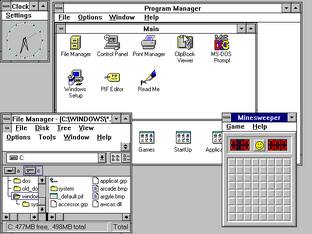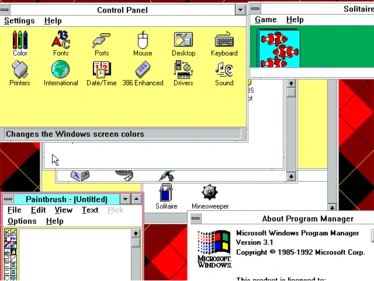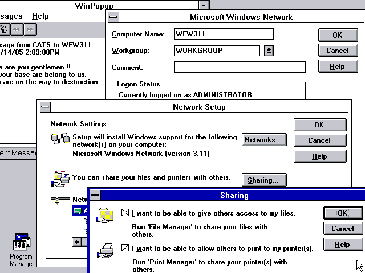
Windows for Workgroups 3.11
Windows 3.1x (codenamed Janus) is a series of 16-bit operating environments produced by Microsoft for use on personal computers. The series began with Windows 3.1, which was first sold during April 1992 as a successor to Windows 3.0. Subsequent versions were released between 1992 and 1994 until the series was superseded by Windows 95. During its lifespan, Windows 3.1 introduced several enhancements to the still MS-DOS–based platform, including improved system stability, expanded support for multimedia, TrueType fonts, and workgroup networking.
Windows 3.1 was originally released on April 6, 1992; official support for Windows 3.1 ended on December 31, 2001, and OEM licensing for Windows for Workgroups 3.11 on embedded systems continued to be available until November 1, 2008.
Editions[]
Windows 3.1[]
Windows 3.1 (originally codenamed Janus), released on April 6, 1992, introduced a TrueType font system (and a set of highly legible fonts), which effectively made Windows a viable desktop publishing platform for the first time. Similar functionality was available for Windows 3.0 through Adobe Type Manager (ATM) font system from Adobe.
Windows 3.1 was designed to have backward compatibility with older Windows platforms. As with Windows 3.0, version 3.1 had File Manager and Program Manager, but unlike all previous versions, Windows 3.1 cannot run in real mode. It included Minesweeper as a replacement for Reversi (though Reversi was still included in some copies).
Windows 3.1 Multimedia PC Version (Beta only, released Nov 1992 – codenamed Bombay) included a media viewer, and the ability to play video files. It was targeted to the new Multimedia PC standard and included sound and video integration with CD-ROM support.
Improvements over Windows 3.0[]

Windows 3.1, showing some of the personalization options available
Windows 3.1 dropped real mode support and required a minimum of an 286 PC with 1 MB of RAM to run. The effect of this was to increase system stability over the crash-prone Windows 3.0. Some older features were removed, like CGA graphics support (although Windows 3.0's CGA driver still worked on 3.1) and compatibility with real-mode Windows 2.x applications.
Truetype font support was added, providing scalable fonts to Windows applications, without having to resort to using a third-party font technology such as Adobe Type Manager. Windows 3.1 included the following fonts: Arial, Courier New, and Times New Roman, in regular, bold, italic, and bold-italic versions, as well as Symbol (a collection of scalable symbols). Truetype fonts could be scaled to any size and rotated, depending on the calling application.
In 386 Enhanced Mode, windowed DOS applications gained the ability for users to manipulate menus and other objects in the program using the Windows mouse pointer, provided that a DOS application supported mice. A few DOS applications, such as late releases of Microsoft Word, could access Windows Clipboard. Windows' own drivers couldn't work directly with DOS applications; hardware such as mice required a DOS driver to be loaded before starting Windows.
Icons could be dragged and dropped for the first time, in addition to having a more detailed appearance. A file could be dragged onto the Print Manager icon and the file would be printed by the current printer, assuming it was associated with an application capable of printing, such as a word processor. Alternatively, the file could be dragged out of File Manager and dropped onto an application icon or window for processing.
While Windows 3.0 was limited to 16 MB maximum memory, Windows 3.1 can access a theoretical 4 GB in 386 Enhanced Mode. (The actual practical ceiling is 256 MB. However, no single process can use more than 16 MB. File Manager was significantly improved over Windows 3.0. Multimedia support was enhanced over what was available in Windows 3.0 with Multimedia Extensions and available to all Windows 3.1 users.
Windows 3.1 was available via 720 KB, 1.2 MB, and 1.44 MB floppy distributions. It was also the first version of Windows to be distributed on CD-ROM — although this was more common for Windows for Workgroups 3.11, which typically came with MS-DOS 6.22 on one CD. Installed size on the hard disk was between 10 MB and 15 MB.
32-bit disk access (386 Enhanced Mode only) brought improved performance by using a 32-bit protected mode driver instead of the 16-bit BIOS functions (which necessitate Windows temporarily dropping out of protected mode).
Windows 3.1's calendar saves its files ending with .cal.
Windows 3.1 also introduced Windows Registry, a centralized database that can store configuration information and settings for various operating systems components and applications.
Windows 3.1 was the first version of Windows that could also launch Windows programs via Command.com while running Windows.
Windows 3.1 for Central and Eastern Europe[]
A special version named Windows 3.1 for Central and Eastern Europe was released that allowed use of Cyrillic and had fonts with diacritical marks characteristic of Central and Eastern European languages. Microsoft introduced its own code page (Windows-1250) and supported its use in violation of many countries' ISO standards (e.g., the official Polish codepage is ISO-8859-2, which was ignored by Microsoft but is supported by contemporary Internet Explorer versions). Similarly, Microsoft also released Windows 3.1J with support for Japanese, which shipped 1.46 million copies in its first year on the market (1993) in Japan.
Modular Windows[]
Modular Windows is a special version of Windows 3.1, designed to run on Tandy Video Information System.
Windows 3.11[]
Windows 3.11 was released on November 8, 1993. It did not add any feature improvements over Windows 3.1; it only corrected problems. Microsoft replaced all retail versions of Windows 3.1 with Windows 3.11 and provided a free upgrade to anyone who currently owned Windows 3.1.
Windows 3.2[]
On November 22, 1993, Microsoft released a Simplified Chinese version of Windows for the Chinese market. A year later, an update was released, which identified itself as Windows 3.2. Thus, Windows 3.2 is an updated version of the Chinese version of Windows 3.1. The update was limited to this language version, as it only fixed issues related to the complex input system for the Chinese language.
Windows 3.2 was generally sold by computer manufacturers with a ten-disk version of MS-DOS that also had Simplified Chinese characters in basic output and some translated utilities.
Windows for Workgroups[]
Windows for Workgroups is an extension that allowed users to share their resources and to request those of others without a centralized authentication server. It used SMB protocol over NetBIOS.
Windows for Workgroups 3.1[]

Network capabilities of Windows for Workgroups 3.11
Windows for Workgroups 3.1 (originally codenamed Winball and later Sparta), released in October 1992, is an extended version of Windows 3.1 that features native networking support. It comes with SMB file sharing support via NetBIOS-based NBF and/or IPX network transport protocols and introduces the Hearts card game and VSHARE.386, a VxD version of SHARE.EXE (a terminate-and-stay-resident program).
Windows for Workgroups 3.11[]
Windows for Workgroups 3.11 (originally codenamed Snowball) was released on August 11, 1993, and shipped in November 1993. It supported 32-bit file access, full 32-bit network redirectors, and VCACHE.386 file cache, shared between them. WFW 3.11 dropped standard mode support and requires a 386 machine to run.
A Winsock package was required to support TCP/IP networking in Windows 3.x. Usually third-party packages were used, but in August 1994, Microsoft released an add-on package (codenamed Wolverine) that provided TCP/IP support in Windows for Workgroups 3.11. Wolverine was a 32-bit stack (accessible from 16-bit Windows applications via WinSock Thunk), which gave it superior performance to most of the third-party TCP/IP Windows stacks available. However, it was only compatible with Windows for Workgroups 3.11, and lacked support for dial-up. Wolverine stack was an early version of the TCP/IP stack that would later ship with Windows 95, and provided an early testbed for the 16-to-32-bit compatibility layer that was crucial to Windows 95's success.
Following the release of MS-DOS 6.22 in 1994, WFW 3.11 largely replaced Windows 3.1 for OEM installations on new PCs due to its improved capabilities and greater stability.
